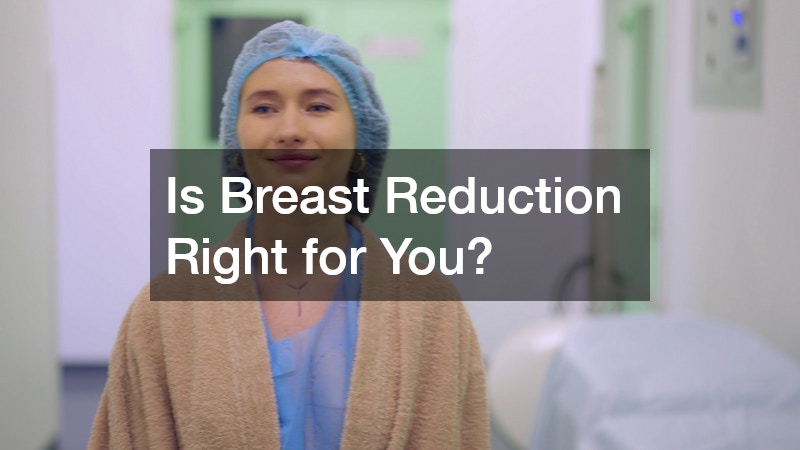For many individuals with large breasts, chronic neck and back pain can be an everyday burden. Activities like exercising, sleeping, or even sitting for extended periods can lead to discomfort and fatigue. While over-the-counter medications and posture adjustments might offer short-term relief, they rarely resolve the root of the problem. For those seeking a long-term solution, breast reduction surgery has become a life-changing option. More than just a cosmetic procedure, breast reduction can significantly improve physical comfort and overall well-being.
Here’s how it works—and why it’s often recommended by plastic surgery professionals for pain relief.
The Physical Strain of Large Breasts
Excessively large breasts—also known as macromastia—can place a significant amount of weight on the chest, pulling the shoulders forward and altering spinal alignment. This imbalance can lead to chronic pain in the neck, shoulders, and upper or lower back. In some cases, it may even affect breathing and circulation. Additionally, the constant pressure of bra straps digging into the skin can cause grooves, irritation, and nerve compression.
These physical symptoms are often compounded by lifestyle limitations. Many individuals with large breasts avoid physical activity due to discomfort, which can lead to muscle weakness and worsen postural issues. Clothing options may also be restricted, creating emotional stress and impacting confidence. For patients dealing with both physical and mental strain, breast reduction offers an opportunity to regain balance—literally and figuratively.
What Is Breast Reduction Surgery?
Breast reduction, or reduction mammoplasty, is a plastic surgery procedure designed to remove excess breast tissue, fat, and skin to achieve a more proportionate breast size. The surgery also lifts and reshapes the breasts, often repositioning the nipples for a more natural look. In most cases, the surgeon removes enough tissue to alleviate discomfort while preserving the patient’s desired shape and symmetry.
Performed under general anesthesia, breast reduction typically takes 2 to 4 hours depending on the extent of the procedure. Most patients go home the same day and begin noticing improvements in posture and comfort shortly after recovery begins. While the cosmetic enhancements are significant, many patients pursue the surgery primarily for pain relief and improved mobility.
How Breast Reduction Eases Neck and Back Pain
By reducing the size and weight of the breasts, this surgery removes the root cause of spinal and muscular strain. With less weight pulling the upper body forward, the spine and shoulders return to a more natural alignment. This can lead to:
- Improved posture: Many patients naturally stand straighter after surgery, reducing stress on the spine and muscles.
- Decreased muscle tension: Without the added weight, muscles in the neck and back no longer need to overcompensate to maintain balance.
- Fewer tension headaches: Tension in the neck and shoulders is a common cause of headaches, which often subside after surgery.
- Improved sleep comfort: Being able to lie flat without discomfort allows for deeper, more restful sleep.
These changes often occur within weeks of surgery, and for many, the relief is immediate. As healing progresses, physical activity becomes easier, further strengthening the muscles that support good posture and spinal health.
The Role of Plastic Surgery in Functional Relief
While plastic surgery is often associated with aesthetic improvements, procedures like breast reduction offer both cosmetic and medical benefits. In fact, breast reduction is one of the few plastic surgery procedures frequently covered by health insurance—when medical documentation supports its necessity. Surgeons often collaborate with primary care providers, physical therapists, or chiropractors to demonstrate that conservative treatments haven’t resolved the issue, reinforcing the need for surgical intervention.
During your consultation, a board-certified plastic surgeon will evaluate your symptoms, breast size, body frame, and overall health to determine whether breast reduction is the right solution. They’ll also discuss realistic expectations and recovery timelines, helping you understand the surgical process and what kind of results to anticipate.
Posture and Alignment Benefits After Surgery
Beyond pain relief, many patients notice a visible improvement in posture after breast reduction. With the upper body no longer pulled forward by excess weight, the shoulders relax into a more neutral position and the spine regains its natural curve. This improved alignment enhances balance and stability and can help prevent future injuries.
Physical therapy post-surgery can further strengthen the muscles of the core and back, promoting even greater support for posture. Some patients who suffered from sciatica or nerve impingement due to poor alignment find that symptoms lessen or disappear after breast reduction. This ripple effect on the musculoskeletal system is one reason plastic surgery is increasingly recognized for its functional, not just aesthetic, value.
Life After Breast Reduction
Most patients describe life after breast reduction as liberating. The ability to move freely without pain or self-consciousness opens doors to new activities and healthier habits. You may find that:
- Exercise becomes more enjoyable and sustainable
- Clothing fits more comfortably and opens new style options
- Fatigue from poor posture and strain begins to fade
- Confidence improves, contributing to better mental health
It’s important to note that while pain relief is significant, long-term results depend on maintaining a healthy weight and posture. Excess weight gain or poor ergonomics can reintroduce discomfort, even after surgery. Fortunately, the increased comfort and mobility post-reduction often inspire more consistent physical activity and self-care.

Is Breast Reduction Right for You?
If you’ve been struggling with persistent neck, shoulder, or back pain despite making lifestyle changes, it may be time to explore plastic surgery as a long-term solution. Breast reduction is often recommended when:
- Conservative treatments (like physical therapy or chiropractic care) have failed
- Breast size is disproportionate to your frame
- You experience posture issues or nerve pain
- Your daily life is limited by discomfort or self-consciousness
A consultation with a skilled plastic surgeon can help determine if you’re a good candidate for the procedure. They will consider your health history, goals, and the potential benefits surgery can provide.
Chronic neck and back pain caused by large breasts isn’t something you have to live with. Breast reduction surgery offers lasting relief by removing the physical strain and allowing your body to realign itself. As a functional form of plastic surgery, it blends physical improvement with aesthetic transformation, providing a higher quality of life and renewed confidence. If you’re ready to reclaim comfort in your body, consider speaking with a board-certified plastic surgery provider about the benefits of breast reduction.



